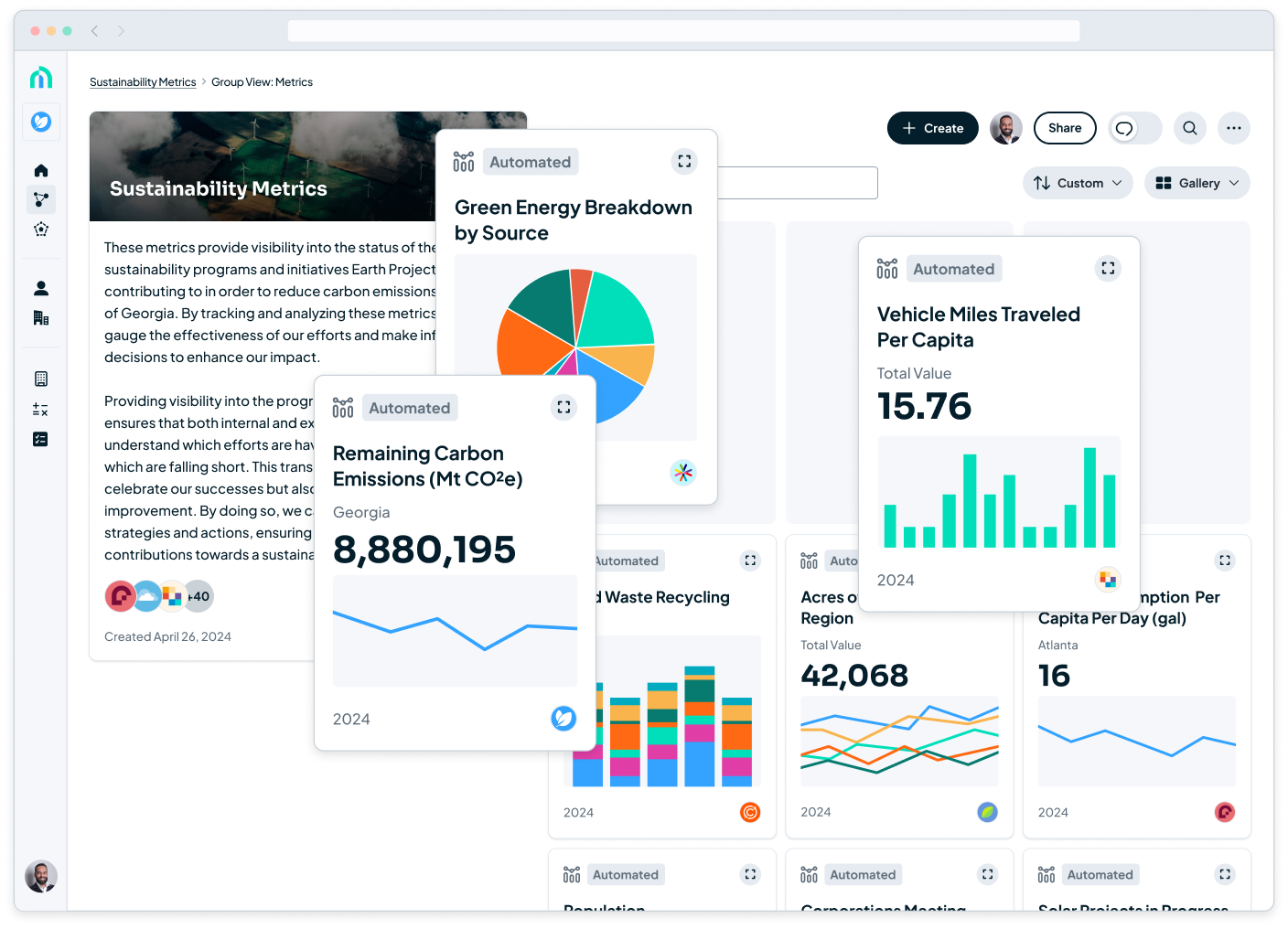Outcome-Based Metrics
Outcome-based metrics are used to quantitatively determine whether or not you have achieved a certain outcome. In other words, they help businesses monitor progress on specific processes and measure the effectiveness of those processes in delivering a certain outcome.
Outcome-based models and product management metrics are common across industries thanks to their usefulness in value measurement. Having a solid framework in place to track the delivery of value can prevent misalignment between buyers and suppliers and other business partnerships. Outcome measures help everyone involved ensure that expected value is being delivered. Rather than relying on guesswork, you can access helpful, relevant data to track your progress on outcomes.
Metaimpact offers a unique network that brings companies together to track outcome-based metrics and the delivery of value, allowing for better business relationships. Metaimpact breaks down silos that prevent alignment between parties, thereby promoting better outcomes from which all key stakeholders benefit.
This article will compare outcome-based metrics to product management metrics, performance metrics, and more. It will detail the importance of each and how they can be applied to different business types and models, as well as how Metaimpact can help your organization achieve better alignment with stakeholders on value delivery.
Outcome Metrics vs. KPIs
The terms “outcome metrics” and “KPIs” are often used interchangeably, but there are some major differences between outcome vs KPI to be aware of. KPIs, or key performance indicators, measure progress in reaching certain goals, while metrics focus on the overall health or success of your business. When considering the terms “metric” vs “indicator” or “KPI” vs “metric,” it’s important to note that while all KPIs are technically metrics, not all metrics are KPIs. However, both metrics and KPIs play an important role in delivering value and helping businesses reach their goals. The following are some additional differences between the two.
KPIs:
- Offer comparative insights that guide future actions.
- Incorporate goals and objectives.
- Are initiated by high-level decision-makers.
Outcome Metrics:
- Are relevant for specific areas or aspects of an organization.
- Do not necessarily identify future action.
- Focus on the progress towards outcome achievement.
Viewing different KPI and metrics examples can give you a better understanding of each. For instance, common KPIs include profit, customer lifetime value, and net promoter score. On the other hand, changes in behaviors and attitudes in customers could all be considered outcome metrics.
Outcome Metrics vs. Process Metrics
In addition to understanding the difference between metrics and KPIs, it can also be helpful to consider outcome metrics vs process metrics and how each can be used to support your overall business goals. But first, what is a process measure? Essentially, process measures refer to the steps taken in a process to ensure a particular outcome. Process metrics, then, are used to evaluate those steps and gain deeper insight into a business’s operational performance.
Process measure examples center around the effectiveness of the process used to achieve set goals. In the healthcare field, for instance, process measures may be used to evaluate the steps taken to deliver care to patients with a certain type of cancer.
Studying various outcome, process, and balancing measure examples can help you get a better understanding of what each entails. While outcome metrics focus on end results, process metrics are extremely useful for measuring the effectiveness of the process taken to achieve those results.
By monitoring your activities, you can identify weak spots and work towards improving your business operations. When viewed holistically, outcome and process metrics can be used to both improve the journey and ensure success at the final destination.
Outcome Metrics vs. Product Metrics
Product metrics, sometimes referred to as product outcome metrics, are similar to outcome metrics in that they are used to determine business success. However, where outcome metrics focus on the end result, product metrics capture the ways in which customers interact with your products and how those interactions impact your organization. Product development metrics are a type of product metrics give businesses greater insight into the quality of their products and help them control the way in which they produce those products. Looking at product metrics examples is often helpful for better understanding this concept.
Another common type of product metrics are software engineering product metrics. But what is product metrics in software engineering? Essentially, these metrics are used to measure the quality and production of software engineering products and services. Likewise, B2B product metrics offer insight into B2B products, and so forth.
Asking the right product management metrics questions can help you gain a better understanding of these metrics and how the product metrics framework can help you learn more about the ways in which your products are impacting your overall business success. Metaimpact can show you whether or not your products and value chain are working as intended and whether you’re delivering—or receiving—the value promised.
Outcome Metrics in Performance Management
Outcome metrics in performance management assess various elements of business performance, including program efficiency, finances, and sustainability. Some of the most critical key performance metrics are business, sales, project, and employee performance metrics. Look for performance metrics examples in your industry to learn more about how this concept works.
These outcome based metrics can all be used to support your wider performance management strategy, allowing you to examine your performance from all angles and identify areas for improvement. It can be easy to zone in on particular metrics, such as performance metrics for employees, and neglect other metrics that impact final outcomes. However, with a solid performance management strategy, you can gain deeper visibility into your business processes.
Metaimpact helps to break down the barriers that silo performance, helping users align with their business partners and stakeholders to assess key performance metrics and ensure the delivery of promised value. Companies can connect with vendors, customers, and other relevant players associated with their organization. By staying in touch within Metaimpact’s ecosystem, buyers and vendors alike can build better business relationships, develop strategies for improved performance management, and remain on the same page in terms of value. The Business Value Network provides a space wherein users can access real-time data that can help them work towards common goals and outcomes.
Outcome Metrics Examples
There are several different types of outcome metrics examples, each of which reflect the importance of outcome based metrics across various industries. An outcome metrics example in healthcare is readmission rates.
By examining the rates at which patients are readmitted, hospitals can determine whether or not they’ve delivered on expected care. In manufacturing, outcome measure examples include the number of items produced over a given period of time and the success of certain materials.
Performance metrics examples in retail include sales, ROI, and customer satisfaction are also present. These outcome measures examples demonstrate the importance of tracking outcomes to determine whether or not goals have been met, which is why they are helpful strategic metrics examples.
Examples of Marketing Outcome Metrics
Outcome metrics are especially important in marketing. Outcome-based advertising, outcome-based media planning, and outcome-based messaging all play a crucial role in helping businesses achieve their marketing aims. Why are marketing outcomes so much more difficult to measure than marketing inputs? Understanding the difference is critical.
Some of the top outcome-based marketing examples are in sales, revenue, customer satisfaction, and customer lifetime value. Tracking marketing business outcomes is essential to hitting your marketing goals. Studying different marketing outcomes examples can give you a better understanding of how these outcomes work and how they can impact your overall marketing strategy. They can also help you make sense of the results of a marketing campaign.
Understanding the “outcome-based marketing” meaning is crucial to understanding the importance of outcomes and how each outcome of digital marketing can impact your business success. But why are marketing outcomes so much more difficult to measure than marketing inputs? Outcomes, unlike inputs, describe end results. Inputs are simply the means by which activities are carried out, and it’s often easier to track the success of the activity itself than measure the overall effectiveness of the campaign by the final outcome. Businesses can easily determine whether or not activities are successful on their own, but the true measure of success is whether or not they’ve positively impacted the end result, which requires deeper insight.
Examples of Health Outcome Metrics
Healthcare organizations track outcomes extensively, but why are outcome measures important in healthcare? Outcome measures are important in healthcare for the simple fact that they allow health providers to make better decisions about how to offer care. Without studying process and outcome measures in healthcare, providers have no way of knowing whether or not they’re delivering on expected outcomes. Outcome metrics give them a big-picture view of the effectiveness of their activities. Some of the most prominent health outcomes examples include mortality, care effectiveness, timeliness of care, and the effective use of medical equipment.
It’s also important that healthcare organizations track quality metrics, which are used to determine the quality of the patient experience. Patient safety during hospital stays, hospital discharge rate, and self-reported patient satisfaction levels are all quality metrics in healthcare examples. Process measure examples in healthcare can help providers gain a better understanding of why processes should be measured and evaluated and how data obtained from these analyses can be used to achieve better results down the road. By viewing examples of structure, process, and outcome in healthcare, you can learn more about how various metrics impact the quality of care patients receive. For this reason, outcome metrics in healthcare are of utmost importance.








